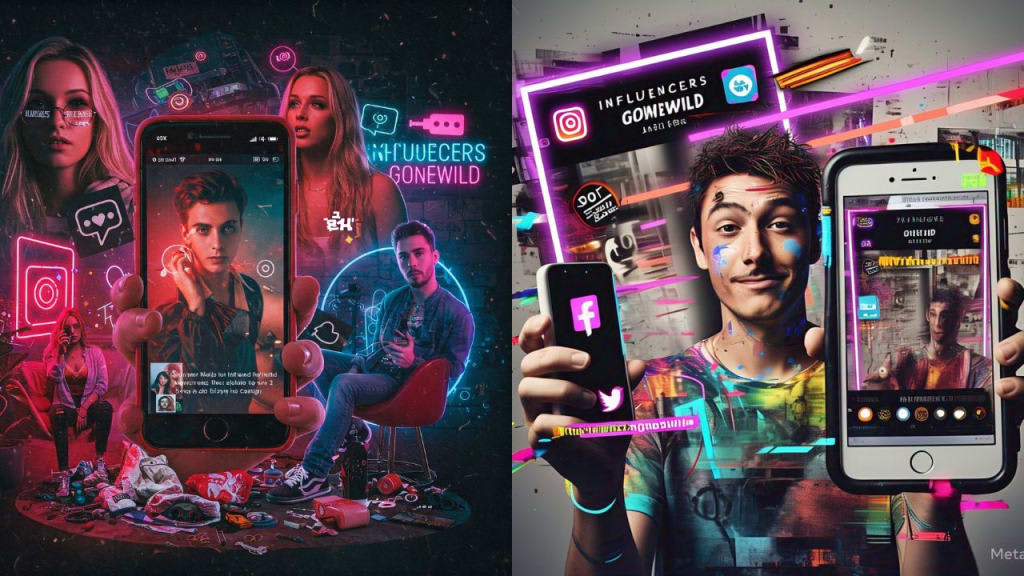InfluencersGoneWild – What It Means & Why It Matters
In today’s fast-paced digital world, “influencersgonewild” refers to creators who push boundaries—through extreme stunts, controversial statements, or raw authenticity—to achieve virality. This trend has reshaped social media norms, with consequences that ripple far beyond entertainment.
1. Defining “InfluencersGoneWild”
At its core, the phrase means influencers going outside the usual content—showcasing outrageous acts (like grabbing wild animals), staging shock-value content (wild house parties), or unveiling real-life dramas. These moments are designed to spark conversation and break through algorithmic noise.
2. The Rise of Viral Behaviors
Platforms like TikTok, Instagram, and YouTube reward engagement—leading influencers to seek high-retention, eye-catching content. Algorithmic feeds amplify dramatic or bizarre moments, making “gone wild” content a strategic way to stay in the spotlight
3. Case Studies of Wild Moments
-
Wildlife Missteps: Influencers provoking animals, like “Wombat Woman” disturbing a baby wombat, sparked outrage and political intervention news.com.au.
-
Party Phenomena: Lavish, uninhibited events documented online can attract large audiences but risk chaos and legal backlash.
-
Shock Stunts: Physical challenges or exposing unfiltered behavior tap into viewers’ thrill-seeking instincts.
4. Psychological Drivers Behind Wild Content
-
Attention & Validation: Many creators tie self-worth to likes and views, prompting risk-taking behavior .
-
FOMO: Staying relevant often means escalating content to keep up with peers and trending creators.
-
Identity Building: Wild content can craft a provocative public persona—effective, but potentially isolating.
5. Audience Response & Engagement Patterns
One of the key reasons “influencersgonewild” content thrives is the immediate reaction it elicits. Shock and surprise naturally boost engagement metrics like shares, comments, and likes. But the audience’s response is more complex than it appears.
-
Shock Effect Spikes: The initial reaction to wild content is often explosive. Videos that defy expectations—like jumping off rooftops, confronting strangers, or public meltdowns—tend to rack up millions of views in hours.
-
Curiosity vs. Loyalty Split: While some followers are drawn in by the thrill, others may start questioning the influencer’s authenticity. This divide often determines whether the influencer’s popularity is sustainable or fleeting.
-
Trust Erosion After the Hype: Wild content may earn momentary fame, but repeated stunts can lead to loss of credibility. Audiences are increasingly wary of “fake drama” or manipulative tactics used to chase virality.
6. Ethical & Legal Implications
As influencers take wilder routes to fame, they also flirt with legal and ethical boundaries.
-
Wildlife Cruelty & Nature Violations: Videos involving animals or protected environments can cross ethical lines. Several influencers have faced legal action for endangering wildlife or trespassing.
-
Sponsorship Transparency: Some wild content is staged in partnership with brands, without disclosure. This violates advertising laws in many countries and can result in penalties or bans.
-
Copyright & Intellectual Property Issues: Use of unlicensed music, filming in restricted areas, or mimicking other creators without permission are other common pitfalls.
Governments and platforms are tightening regulations, urging creators to think beyond views and prioritize ethical responsibility.
7. Mental Health Toll on Influencers
The price of fame isn’t just public scrutiny—it’s also emotional exhaustion.
-
Performance Pressure: Constantly topping the last viral hit leads to burnout. Influencers may feel trapped in a cycle of outrageousness.
-
Backlash & Trolling: Going viral often brings trolls, hate comments, and even threats. The emotional toll of managing hate online can be profound.
-
Coping Mechanisms: Many creators are now turning to therapy, mindfulness, and social media detoxes. Still, the pressure to stay relevant never fully disappears.
It’s crucial that fans and platforms recognize these challenges and create supportive spaces for content creators.
8. Brand Collaboration: Pros and Pitfalls
Brands often jump on viral moments to gain quick exposure—but working with “wild” influencers is a double-edged sword.
-
Riding the Hype Wave: Some companies benefit from bold, raw influencer marketing campaigns—especially when targeting Gen Z or younger audiences.
-
Reputational Risk: However, brands linked to controversial figures may face backlash themselves. Think of sponsorships pulled when influencers misstep publicly.
-
Choosing Authenticity Over Virality: Increasingly, brands are seeking genuine, values-aligned partnerships rather than chasing flashy but risky content creators.
Marketers must assess whether short-term visibility outweighs long-term brand equity.
9. Future Outlook of Extreme Content
The days of unfiltered shock content dominating platforms may be numbered.
-
Authenticity Resurgence: Audiences are starting to crave more relatable, wholesome, and grounded content. Influencers who share personal growth journeys or community-focused projects are gaining traction.
-
Rise of Micro-Influencers: Smaller creators with niche, engaged audiences are proving more trustworthy—and cost-effective—for brands.
-
Platform Regulation: Social networks like TikTok and Instagram are updating algorithms to demote content that encourages dangerous or unethical behavior.
The wild era might be winding down, making room for a healthier, more responsible form of influence.
FAQs About Influencersgonewild
1. What counts as “gone wild” for influencers?
It refers to behavior that breaks typical social or platform norms—like risky stunts, shocking revelations, or extremely raw emotional content.
2. Why does this type of content go viral?
Because it triggers strong emotional responses—shock, curiosity, or even outrage—which fuels engagement algorithms.
3. Are brands okay with this content style?
Some are, especially edgy or youth-targeted brands. But most prefer safer, value-aligned influencers to protect their image.
4. How can audiences enjoy this content responsibly?
Be critical of what you consume. Look for transparency, question harmful behavior, and support creators who promote ethics.
5. Can influencers recover from wild controversies?
Yes—many have. Redemption often comes through accountability, authentic apologies, and a shift in content tone.
6. How can we support influencers’ mental health?
Show compassion online, avoid toxic comments, and uplift creators who share responsibly and honestly.
Conclusion Of Influencersgonewild
Influencersgonewild is more than a trend—it’s a reflection of how far digital fame can push people. While the entertainment factor is undeniable, it’s vital to balance excitement with empathy, and visibility with responsibility. As audiences, brands, and platforms evolve, so too will our standards for what it means to influence.

